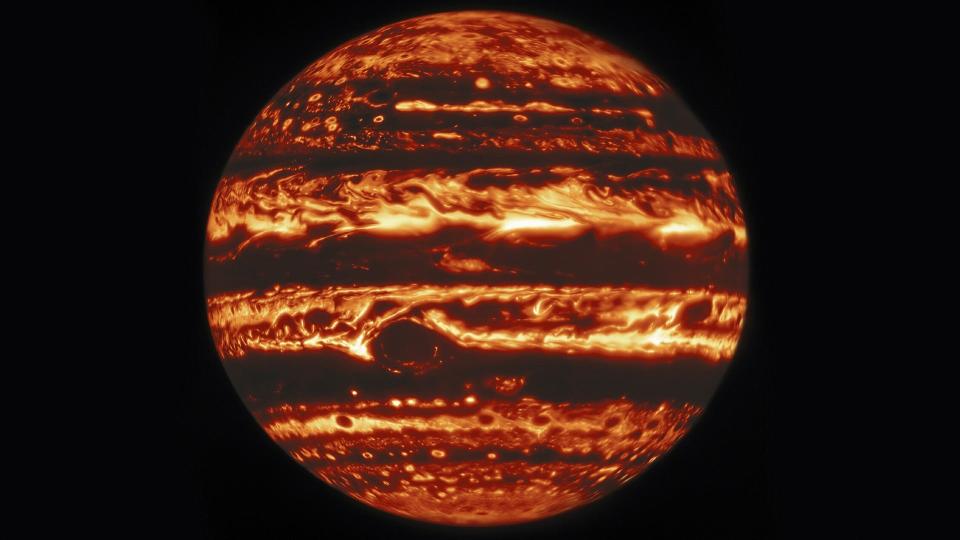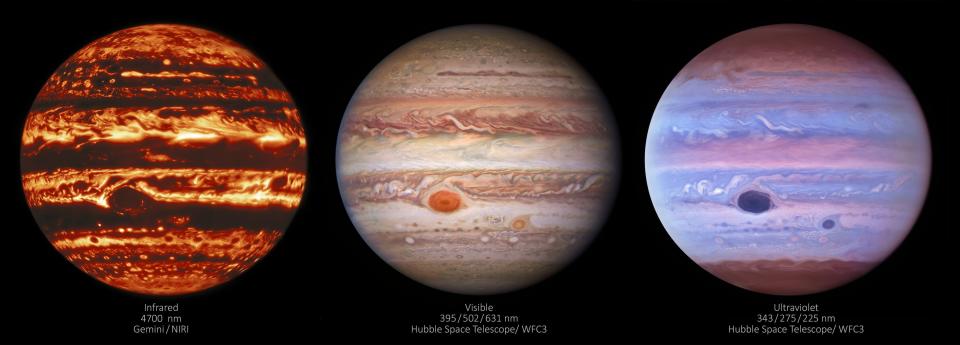Nasa releases astounding images of Jupiter – and finds a mystery in its Giant Red Spot

Nasa and the European Space Agency has released astonishing new images of Jupiter, revealing its Great Red Spot, superstorms, cyclones, and more.
Jupiter is the largest planet in our solar system, with a radius 11 times wider than Earth (69,911 kilometers); if Earth were the size of a 20 pence coin, Jupiter would be about as big as a basketball.
Three images were taken of this gas giant simultaneously in 2017; one using infrared light, one using visible light, and a final one with ultraviolet radiation.
The Giant Red Spot - a persistent storm easily large enough to engulf our planet whole – is prominent in the visible and ultraviolet images but is almost lost at infrared wavelengths. This can also be used by scientists to locate chromophores, which are particles that give the storm its colouring by absorbing blue and ultraviolet light.
The observations have already led to some surprising findings: gaps in the Great Red Spot which look like clouds in visible light, but which actually are not there. While the holes have not been fully explained, the University of California’s Mike Wong hypothesises that these might be akin to “eddies in the ocean.”
He continued: “As the storm clouds spin, you can get little anomalies from these eddies that form streaks by just winding up. And that’s kind of the shape that we’re seeing in these holes. So it’s probably just some weak turbulence, but as it spins, it gets stretched out.”

Red Spot Jr, a smaller storm located to the bottom right of its larger sibling, is also visible using normal and ultraviolet light.In the visible-wavelength image, it has a clearly-defined red outer rim with a white centre, but that is lost amid larger clouds in the infrared view.
The infrared image also reveals a bright streak in Jupiter’s northern hemisphere. This is a cyclonic vortex – or perhaps, the Gemini North observatory suggests, a series of vortices – that is 72,000 kilometers in size.
At visible wavelengths the cyclone appears dark brown, leading to these types of features being called ‘brown barges’ in images from Nasa’s Voyager spacecraft. Below those are four large ‘hot spots’, which were first discovered in the 1960s.
The visible and ultraviolet views were captured by the Wide Field Camera 3 on the Hubble Space Telescope, while the infrared image comes from the Near-InfraRed Imager (NIRI) instrument at Gemini North in Hawaiʻi.
Read More
Bitcoin price heading towards $250,000, predicts senior hedge fund executive
Crypto price live: Ethereum and cardano hit record highs as bitcoin and dogecoin settle
Ethereum price shoots to new all-time high as experts make $20,000 prediction

 Yahoo Finance
Yahoo Finance 